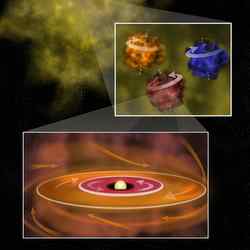
A huge star-forming region can give birth to multiple stellar systems, as shown in the top view. Image credit: NASA Click to enlarge
Call it the biggest beltway ever seen. Astronomers have discovered a newly forming solar system with the inner part orbiting in one direction and the outer part orbiting the other way.
Our solar system is a one-way boulevard. All the planets – from Mercury out to Pluto and even the newly discovered objects beyond – revolve around the Sun in the same direction. This is because the Sun and planets formed from the same massive, rotating cloud of dust and gas. The motion of that cloud set the motion of the planets.
The fact that a solar system can have planets running in opposite directions is a shocker.
“This is the first time anyone has seen anything like this, and it means that the process of forming planets from such disks is more complex than we previously expected,” said Anthony Remijan of the National Radio Astronomy Observatory.
Remijan and his colleague Jan Hollis of NASA Goddard Space Flight Center in Greenbelt, Md., used the National Science Foundation’s Very Large Array radio telescope to make the discovery.
Call it one of the largest road construction projects, too. This solar system, about 500 light-years from Earth in the direction of the constellation Ophiuchus, is a work in progress. At its center is a young star. No planets have formed yet and likely won’t for millions of years. What Remijan and Hollis saw were two flat and dusty disks rotating around the equatorial plane of the central star in opposite directions.
“The solar system that likely will be formed around this star will include planets orbiting in different directions, unlike our own solar system,” Hollis said.
How did this rare scenario come to be?
“We think this system may have gotten material from two clouds instead of one, and the two were rotating in opposite directions,” Remijan said.
There is sufficient material to form planets from both parts of the disk, he added. The budding solar system is in a large, star-forming region where chaotic motions and eddies in the gas and dust result in smaller cloudlets that can rotate in different directions.
Remijan and Hollis study star-forming clouds by analyzing radio waves emitted by molecules within the clouds at specific, known frequencies. The motion of the molecules will cause the frequency to shift to a higher or lower frequency, depending on the direction of the motion. This is called a Doppler shift. Actually, it is the same technology that police officers use to nab speeders on a beltway.
The VLA observations of the “beltway” solar system revealed the motion of silicon monoxide (SiO) molecules. These emit radio waves at about 43 GigaHertz (GHz). When Remijan and Hollis compared new VLA measurements of the motion of SiO molecules close to the young star with earlier measurements of other molecules farther away from the protostar, they realized the two were orbiting the star in opposite directions.
This is the first time such a phenomenon has been seen in a disk around a young star. Yet who’s to say the arrangement is uncommon? As astronomers find more and more extra-solar planets (over a hundred so far and counting), they are realizing that solar systems come in many shapes and sizes.
A paper describing this result will appear in the April 1 edition of the Astrophysical Journal.
The VLA comprises 27 radio antennas spread out across 36 kilometers in a Y formation outside of Socorro, N.M. This is the site featured in the movie Contact. The National Radio Astronomy Observatory operates the facility.
Original Source: NASA News Release
What is the biggest planet?
